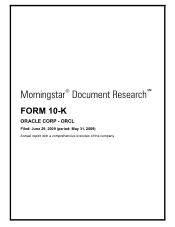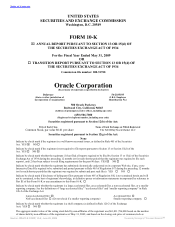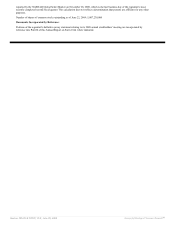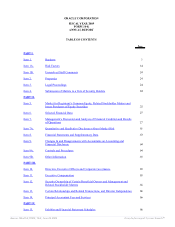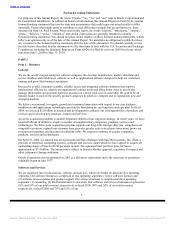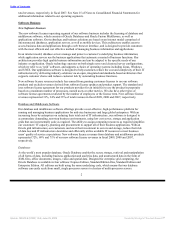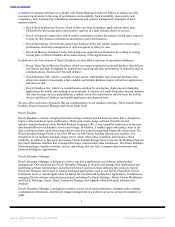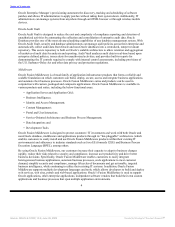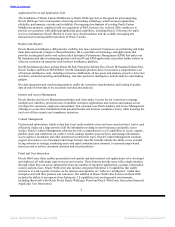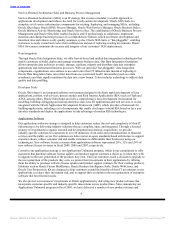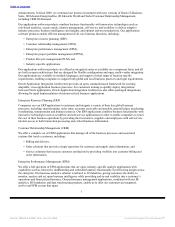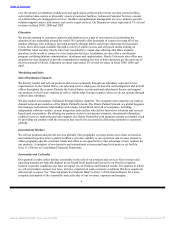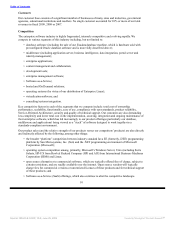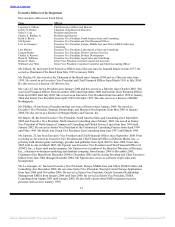Oracle 2008 Annual Report Download - page 10
Download and view the complete annual report
Please find page 10 of the 2008 Oracle annual report below. You can navigate through the pages in the report by either clicking on the pages listed below, or by using the keyword search tool below to find specific information within the annual report.
Table of Contents
Application Server and Application Grid
The foundation of Oracle Fusion Middleware is Oracle WebLogic Server. Designed for grid computing,
Oracle WebLogic Server incorporates clustering and caching technology, which increases application
reliability, performance, security and scalability. Our ongoing development of existing Oracle Fusion
Middleware products, combined with our acquisition of BEA Systems, Inc. in fiscal 2008, enables us to
provide our customers with additional application grid capabilities, including Oracle Coherence for rapid
access to information, Oracle JRockit to create Java virtual machines and the scalable messaging and
transaction processing platform products of Oracle Tuxedo.
Business Intelligence
Oracle Business Intelligence (BI) provides visibility into how customers’ businesses are performing and helps
them plan and model to improve that performance. BI is a portfolio of technology and applications that
provides an integrated end-to-end system called Enterprise Performance Management (EPM) that unites our
BI foundation and data warehousing products with our BI and EPM applications (described further below) to
offer our customers an enterprise-wide business intelligence platform.
Our BI foundation products include Oracle BI Suite Enterprise Edition Plus, Oracle BI Standard Edition One,
Oracle Essbase and Oracle BI Publisher. Our BI foundation products deliver customers a comprehensive set
of business intelligence tools, including interactive dashboards, ad hoc query and analysis, proactive detection
and alerts, advanced reporting and publishing, real-time predictive intelligence, mobile analytics and desktop
gadgets.
Our data integration and warehousing products enable the extraction, transformation and loading of quality
data in order for that data to be accurately searched and analyzed.
Identity and Access Management
Oracle Identity and Access Management products and suites make it easier for our customers to manage
multiple user identities, provision users in multiple enterprise applications and systems and manage access
privileges for customers, employees and partners. Our customers use Oracle Identity and Access Management
offerings to secure their information from potential threats and increase compliance levels, while lowering the
total cost of their security and compliance initiatives.
Content Management
Unstructured information, which is data that is not easily readable or has not been stored so that it can be used
efficiently, makes up a large portion of all the information residing in most businesses and public sector
entities. Oracle Content Management solutions provide a comprehensive set of capabilities to create, capture,
publish, share and collaborate on, archive, retain, manage business process flows and manage information
access rights to documents and other unstructured content file types. Oracle Content Management solutions
support an extensive set of document and image formats. Specific benefits include the ability to use external
facing websites as strategic marketing assets and rapid communication channels, to automate paper-based
processes and to enforce document retention and security policies.
Portal and User Interaction
Oracle WebCenter Suite enables personalized web portals and task-oriented web applications to be developed
and deployed, all with single sign-on access and security. These features provide users with a single interface
through which they can access information from any number of enterprise applications, systems, information
sources and processes. Oracle WebCenter also includes integrated Enterprise 2.0 capabilities that enable
customers to work together in teams via the internet and capitalize on “collective intelligence” within their
enterprise and with their partners and customers. The addition of Oracle WebCenter Services in fiscal 2009
includes the ability to incorporate these Enterprise 2.0 capabilities into existing portal environments,
including those built with Oracle Portal, Oracle WebLogic Portal and Oracle WebCenter Interaction (formerly
AquaLogic User Interaction).
5
Source: ORACLE CORP, 10-K, June 29, 2009 Powered by Morningstar® Document Research℠

